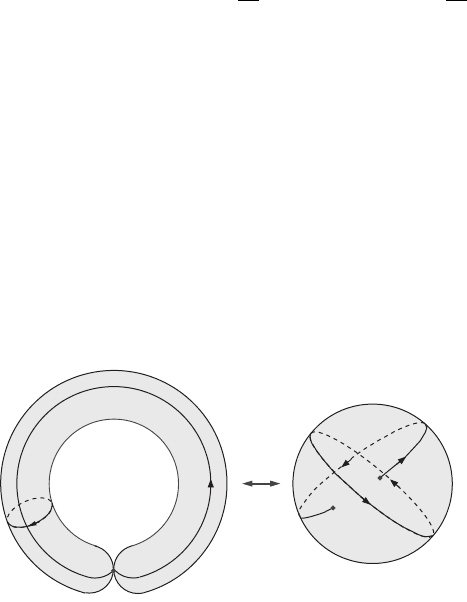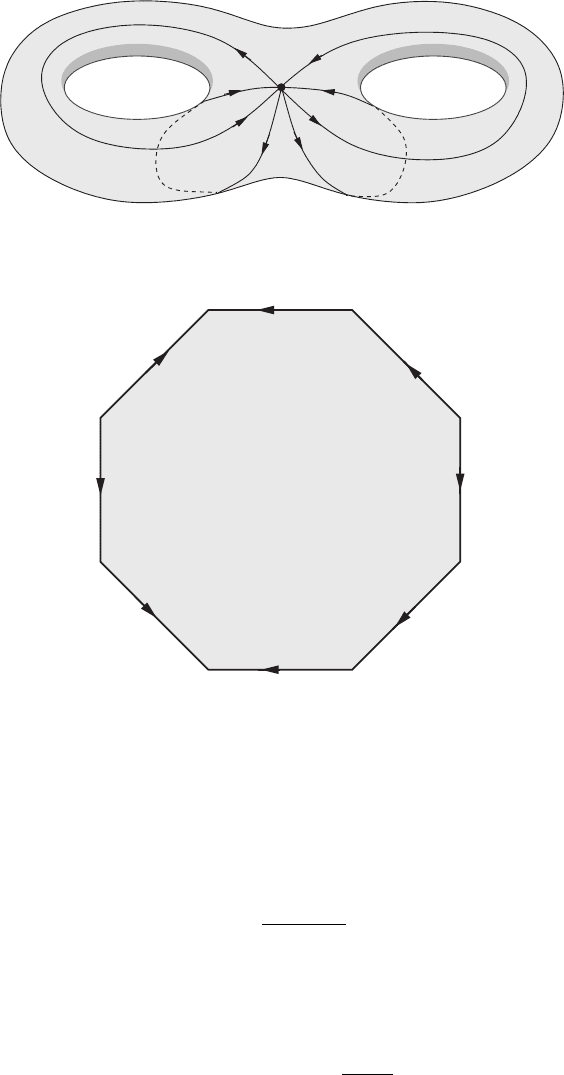Stone M., Goldbart P. Mathematics for Physics: A Guided Tour for Graduate Students
Подождите немного. Документ загружается.


17.6 Analytic functions and topology 655
In order to capture all its points at infinity, we often consider a complex algebraic
curve as being a subset of CP
2
. To do this we make the defining equation homogeneous
by introducing a third coordinate. For example, for (17.165) we make
P(z, w) = z
3
+ 3w
2
z + w +3 → P(z, w, v) = z
3
+ 3w
2
z + wv
2
+ 3v
3
. (17.168)
The points where P (z, w, v) = 0 define
7
a projective curve lying in CP
2
. Places on this
curve where the coordinate v is zero are the added points at infinity. Places where v is
non-zero (and where we may as well set v = 1) constitute the original affine curve.
A generic (non-singular) curve
P(z, w) =
r,s
a
rs
z
r
w
s
= 0, (17.169)
with its points at infinity included, has genus
g =
1
2
(d − 1)(d − 2). (17.170)
Here d = max (r + s) is the degree of the curve. This degree–genus relation is due to
Plücker. It is not, however, trivial to prove. Also not easy to prove is Riemann’s theorem
of 1852 that any finite genus Riemann surface is the complex algebraic curve associated
with some two-variable polynomial.
The two assertions in the previous paragraph seem to contradict each other. “Any”
finite genus must surely include g = 2, but how can a genus 2 surface be a complex
algebraic curve? There is no integer value of d such that (d − 1)(d − 2)/2 = 2. This
is where the “non-singular” caveat becomes important. An affine curve P(z, w) = 0is
said to be singular at P = (z
0
, w
0
) if all of
P(z, w),
∂P
∂z
,
∂P
∂w
,
vanish at P. A projective curve is singular at P ∈ CP
2
if all of
P(z, w, v),
∂P
∂z
,
∂P
∂w
,
∂P
∂v
are zero there. If the curve has a singular point then it degenerates and ceases to be a man-
ifold. Now Riemann’s construction does not guarantee an embedding of the surface into
CP
2
, only an immersion. The distinction between these two concepts is that an immersed
surface is allowed to self-intersect, while an embedded one is not. Being a double root of
the defining equation P(z, w) = 0, a point of self-intersection is necessarily a singular
point.
7
A homogeneous polynomial P(z, w, v) of degree n does not provide a map from CP
2
→ C because
P(λz, λw, λv ) = λ
n
P(z, w, v ) usually depends on λ, while the coordinates (λz, λw, λv) and (z, w, v)
correspond to the same point in CP
2
. The zero set where P = 0 is, however, well defined in CP
2
.

656 17 Complex analysis
As an illustration of a singular curve, consider our earlier example of the curve
w
2
= (z −a)(z − b)(z − c)(z −d) (17.171)
whose Riemann surface we know to be a torus once some points are added at infinity,
and when a, b, c, d are all distinct. The degree–genus formula applied to this degree-
four curve gives, however, g = 3 instead of the expected g = 1. This is because the
corresponding projective curve
w
2
v
2
= (z −av)(z − bv )(z − cv)(z − dv) (17.172)
has a tacnode singularity at the point (z, w, v ) = (0, 1, 0). Rather than investigate this
rather complicated singularity at infinity, we will consider the simpler case of what
happens if we allow b to coincide with c. When b and c merge, the finite point P =
(w
0
, z
0
) = (0, b) becomes singular. Near the singularity, the equation defining our curve
looks like
0 = w
2
− ad (z − b)
2
, (17.173)
which is the equation of two lines, w =
√
ad (z − b) and w =−
√
ad (z − b), that
intersect at the point (w, z) = (0, b). To understand what is happening topologically it
is first necessary to realize that a complex line is a copy of C and hence, after the point
at infinity is included, is topologically a sphere. A pair of intersecting complex lines
is therefore topologically a pair of spheres sharing a common point. Our degenerate
curve only looks like a pair of lines near the point of intersection however. To see the
larger picture, look back at the figure of the twice-cut plane where we see that as b
approaches c we have an α cycle of zero total length. A zero length cycle means that the
circumference of the torus becomes zero at P, so that it looks like a bent sausage with
its two ends sharing the common point P. Instead of two separate spheres, our sausage
is equivalent to a single two-sphere with two points identified.
As it stands, such a set is no longer a manifold because any neighbourhood of P will
contain bits of both ends of the sausage, and therefore cannot be given coordinates that
P
P
P
Figure 17.21 A degenerate torus is topologically the same as a sphere with two points identified.

17.6 Analytic functions and topology 657
make it look like a region in R
2
. We can, however, simply agree to delete the common
point, and then plug the resulting holes in the sausage ends with two distinct points. The
new set is again a manifold, and topologically a sphere. From the viewpoint of the pair
of intersecting lines, this construction means that we stay on one line, and ignore the
other as it passes through.
A similar resolution of singularities allows us to regard immersed surfaces as non-
singular manifolds, and it is in this sense that Riemann’s theorem is to be understood.
When n such self-intersection double points are deleted and replaced by pairs of distinct
points the degree–genus formula becomes
g =
1
2
(d − 1)(d − 2) − n, (17.174)
and this can take any integer value.
17.6.4 Conformal geometry of Riemann surfaces
In this section we recall Hodge’s theory of harmonic forms from Section 13.7.1, and see
how it looks from a complex-variable perspective. This viewpoint reveals a relationship
between Riemann surfaces and Riemann manifolds that forms an important ingredient
in string and conformal field theory.
Isothermal coordinates and complex structure
Suppose we have a two-dimensional orientable Riemann manifold M with metric
ds
2
= g
ij
dx
i
dx
j
. (17.175)
In two dimensions g
ij
has three independent components. When we make a coordinate
transformation we have two arbitrary functions at our disposal, and so we can use this
freedom to select local coordinates in which only one independent component remains.
The most useful choice is isothermal (also called conformal) coordinates x, y in which
the metric tensor is diagonal, g
ij
= e
σ
δ
ij
, and so
ds
2
= e
σ
(dx
2
+ dy
2
). (17.176)
The e
σ
is called the scale factor or conformal factor.Ifwesetz = x +iy and z = x −iy
the metric becomes
ds
2
= e
σ(z,z)
dzdz. (17.177)
We can construct isothermal coordinates for some open neighbourhood of any point
in M . If in an overlapping isothermal coordinate patch the metric is
ds
2
= e
τ(ζ,ζ)
dζ dζ , (17.178)

658 17 Complex analysis
and if the coordinates have the same orientation, then in the overlap region ζ must be a
function only of z and
ζ a function only of z. This is so that
e
τ(ζ,ζ)
dζ dζ = e
σ(z,z)
!
!
!
!
dz
dζ
!
!
!
!
2
dζ dζ (17.179)
without any dζ
2
or dζ
2
terms appearing. A manifold with an atlas of complex charts
whose change-of-coordinate formulae are holomorphic in this way is said to be a complex
manifold, and the coordinates endow it with a complex structure. The existence of a
global complex structure allows us to define the notion of meromorphic and rational
functions on M. Our Riemann manifold is therefore also a Riemann surface.
While any compact, orientable, two-dimensional Riemann manifold has a complex
structure that is determined by the metric, the mapping: metric → complex structure is
not one-to-one. Two metrics g
ij
, ˜g
ij
that are related by a conformal scale factor
g
ij
= λ(x
1
, x
2
)˜g
ij
(17.180)
give rise to the same complex structure. Conversely, a pair of two-dimensional Riemann
manifolds having the same complex structure have metrics that are related by a scale
factor.
The use of isothermal coordinates simplifies many computations. Firstly, observe that
g
ij
/
√
g = δ
ij
, the conformal factor having cancelled. If you look back at its definition,
you will see that this means that when the Hodge “” map acts on 1-forms, the result is
independent of the metric. If ω is a 1-form
ω = pdx+ qdy, (17.181)
then
ω =−qdx+ pdy. (17.182)
Note that, on 1-forms,
=−1. (17.183)
With z = x + iy,
z = x −iy, we have
ω =
1
2
(p − iq) dz +
1
2
(p + iq) d
z. (17.184)
Let us focus on the dz part:
A =
1
2
(p − iq) dz =
1
2
(p − iq)(dx + idy). (17.185)

17.6 Analytic functions and topology 659
Then
A =
1
2
(p − iq)(dy − idx) =−iA. (17.186)
Similarly, with
B =
1
2
(p + iq) d
z (17.187)
we have
B = iB. (17.188)
Thus the dz and d
z parts of the original form are separately eigenvectors of with
different eigenvalues. We use this observation to construct a resolution of the identity Id
into the sum of two projection operators
Id =
1
2
(1 + i) +
1
2
(1 − i),
= P +
P, (17.189)
where P projects on the dz part and
P onto the dz part of the form.
The original form is harmonic if it is both closed dω = 0, and co-closed d ω = 0.
Thus, in two dimensions, the notion of being harmonic (i.e. a solution of Laplace’s
equation) is independent of what metric we are given. If ω is a harmonic form, then
(p − iq)dz and (p + iq)d
z are separately closed. Observe that (p − iq)dz being closed
means that ∂
z
(p−iq) = 0, and so p−iq is a holomorphic (and hence harmonic) function.
Since both (p−iq) and dz depend only on z, we will call (p−iq)dz a holomorphic 1-form.
The complex conjugate form
(p − iq)dz = (p + iq)dz (17.190)
then depends only on
z and is antiholomorphic.
Riemann bilinear relations
As an illustration of the interplay of harmonic forms and two-dimensional topology, we
derive some famous formulæ due to Riemann. These formulæ have applications in string
theory and in conformal field theory.
Suppose that M is a Riemann surface of genus g, with α
i
, β
i
, i = 1, ..., g, the
representative generators of H
1
(M ) that intersect as shown in Figure 17.20. By applying
Hodge–de Rham to this surface, we know that we can select a set of 2g independent,
real, harmonic, 1-forms as a basis of H
1
(M , R). With the aid of the projector P we can
assemble these into g holomorphic closed 1-forms ω
i
, together with g antiholomorphic
closed 1-forms
ω
i
, the original 2g real forms being recovered from these as ω
i
+ ω
i

660 17 Complex analysis
and (ω
i
+ ω
i
) = i(ω
i
− ω
i
). A physical interpretation of these forms is as the z and
z components of irrotational and incompressible fluid flows on the surface M .Itisnot
surprising that such flows form a 2g real dimensional, or g complex dimensional, vector
space because we can independently specify the circulation
E
v·dr around each of the 2g
generators of H
1
(M ). If the flow field has (covariant) components v
x
, v
y
, then ω = v
z
dz
where v
z
= (v
x
− iv
y
)/2, and ω = v
z
dz where v
z
= (v
x
+ iv
y
)/2.
Suppose now that a and b are closed 1-forms on M . Then, either by exploiting the
powerful and general intersection-form formula (13.77) or by cutting open the surface
along the curves α
i
, β
i
and using the more direct strategy that gave us (13.79), we
find that
M
a ∧ b =
g
i=1
α
i
a
β
i
b −
β
i
a
α
i
b
. (17.191)
We use this formula to derive two bilinear relations associated with a closed holomorphic
1-form ω. Firstly we compute its Hodge inner-product norm
ω
2
≡
M
ω ∧ ω =
g
i=1
α
i
ω
β
i
ω −
β
i
ω
α
i
ω
= i
g
i=1
α
i
ω
β
i
ω −
β
i
ω
α
i
ω
= i
g
i=1
A
i
B
i
− B
i
A
i
, (17.192)
where A
i
=
α
i
ω and B
i
=
β
i
ω. We have used the fact that ω is an antiholomorphic 1
form and thus an eigenvector of with eigenvalue i. It follows, therefore, that if all the
A
i
are zero then ω=0 and so ω = 0.
Let A
ij
=
α
i
ω
j
. The determinant of the matrix A
ij
is non-zero: if it were zero, then
there would be numbers λ
i
, not all zero, such that
0 = A
ij
λ
j
=
α
i
(ω
j
λ
j
), (17.193)
but, by (17.192), this implies that ω
j
λ
j
=0 and hence ω
j
λ
j
= 0, contrary to the linear
independence of the ω
i
. We can therefore solve the equations
A
ij
λ
jk
= δ
ik
(17.194)
for the numbers λ
jk
and use these to replace each of the ω
i
by the linear combination ω
j
λ
ji
.
The new ω
i
then obey
α
i
ω
j
= δ
ij
. From now on we suppose that this has been done.

17.7 Further exercises and problems 661
Define τ
ij
=
β
i
ω
j
. Observe that dz ∧ dz = 0 forces ω
i
∧ ω
j
= 0, and therefore we
have a second relation
0 =
M
ω
m
∧ ω
n
=
g
i=1
α
i
ω
m
β
i
ω
n
−
β
i
ω
m
α
i
ω
n
=
g
i=1
{
δ
im
τ
in
− τ
im
δ
in
}
= τ
mn
− τ
nm
. (17.195)
The matrix τ
ij
is therefore symmetric. A similar compuation shows that
λ
i
ω
i
2
= 2λ
i
(Im τ
ij
)λ
j
(17.196)
so the matrix (Im τ
ij
) is positive definite. The set of such symmetric matrices whose imag-
inary part is positive definite is called the Siegel upper half-plane. Not every such matrix
corresponds to a Riemann surface, but when it does it encodes all information about the
shape of the Riemann manifold M that is left invariant under conformal rescaling.
17.7 Further exercises and problems
Exercise 17.11: Harmonic partners. Show that the function
u = sin x cosh y + 2 cos x sinh y
is harmonic. Determine the corresponding analytic function u + iv .
Exercise 17.12: Möbius maps. The map
z (→ w =
az + b
cz + d
is called a Möbius transformation. These maps are important because they are the only
one-to-one conformal maps of the Riemann sphere onto itself.
(a) Show that two successive Möbius transformations
z
=
az + b
cz + d
, z
=
Az
+ B
Cz
+ D
give rise to another Möbius transformation, and show that the rule for combining
them is equivalent to matrix multiplication.
(b) Let z
1
, z
2
, z
3
, z
4
be complex numbers. Show that a necessary and sufficient condition
for the four points to be concyclic is that their cross-ratio
{z
1
, z
2
, z
3
, z
4
}
def
=
(z
1
− z
4
)(z
3
− z
2
)
(z
1
− z
2
)(z
3
− z
4
)

662 17 Complex analysis
be real. (Hint: use a well-known property of opposite angles of a cyclic quadrilateral.)
Show that Möbius transformations leave the cross-ratio invariant, and thus take
circles into circles.
Exercise 17.13: Hyperbolic geometry. The Riemann metric for the Poincaré-disc model
of Lobachevski’s hyperbolic plane (see Exercises 1.7 and 12.13) can be taken to be
ds
2
=
4|dz|
2
(1 −|z|
2
)
2
, |z|
2
< 1.
(a) Show that the Möbius transformation
z (→ w = e
iλ
z − a
¯az − 1
, |a| < 1, λ ∈ R
provides a one-to-one map of the interior of the unit disc onto itself. Show that these
maps form a group.
(b) Show that the hyperbolic-plane metric is left invariant under the group of maps in part
(a). Deduce that such maps are orientation-preserving isometries of the hyperbolic
plane.
(c) Use the circle-preserving property of the Möbius maps to deduce that circles in
hyperbolic geometry are represented in the Poincaré disc by Euclidean circles that
lie entirely within the disc.
The conformal maps of part (a) are in fact the only orientation-preserving isometries of
the hyperbolic plane. With the exception of circles centred at z = 0, the center of the
hyperbolic circle does not coincide with the centre of its representative Euclidean circle.
Euclidean circles that are internally tangent to the boundary of the unit disc have infinite
hyperbolic radius and their hyperbolic centres lie on the boundary of the unit disc and
hence at hyperbolic infinity. They are known as horocycles.
Exercise 17.14: Rectangle to ellipse. Consider the map w (→ z = sin w. Draw a picture
of the image, in the z plane, of the interior of the rectangle with corners u =±π/2,
v =±λ (w = u +iv). Show which points correspond to the corners of the rectangle, and
verify that the vertex angles remain π/2. At what points does the isogonal property fail?
Exercise 17.15: The part of the negative real axis where x < −1 is occupied by a
conductor held at potential −V
0
. The positive real axis for x > +1 is similarly occupied
by a conductor held at potential +V
0
. The conductors extend to infinity in both directions
perpendicular to the x–y plane, and so the potential V satisfies the two-dimensional
Laplace equation.
(a) Find the image in the ζ plane of the cut z plane where the cuts run from −1to−∞
and from +1to+∞ under the map z (→ ζ = sin
−1
z.
(b) Use your answer from part (a) to solve the electrostatic problem and show that the
field lines and equipotentials are conic sections of the form ax
2
+ by
2
= 1. Find

17.7 Further exercises and problems 663
expressions for a and b for both the field lines and the equipotentials and draw a
labelled sketch to illustrate your results.
Exercise 17.16: Draw the image under the map z (→ w = e
πz/a
of the infinite strip S,
consisting of those points z = x + iy ∈ C for which 0 < y < a. Label enough points to
show which point in the w plane corresponds to which in the z plane. Hence or otherwise
show that the Dirichlet Green function G(x, y; x
0
, y
0
) that obeys
∇
2
G = δ(x − x
0
)δ(y − y
0
)
in S, and G(x, y; x
0
, y
0
) = 0 for (x, y) on the boundary of S, can be written as
G(x, y; x
0
, y
0
) =
1
2π
ln |sinh(π(z − z
0
)/2a)|+...
The dots indicate the presence of a second function, similar to the first, that you should
find. Assume that (x
0
, y
0
) ∈ S.
Exercise 17.17: State Laurent’s theorem for functions analytic in an annulus. Include
formulae for the coefficients of the expansion. Show that, suitably interpreted, this
theorem reduces to a form of Fourier’s theorem for functions analytic in a neighbourhood
of the unit circle.
Exercise 17.18: Laurent paradox. Show that in the annulus 1 < |z| < 2 the function
f (z ) =
1
(z − 1)(2 − z )
has a Laurent expansion in powers of z. Find the coefficients. The part of the series
with negative powers of z does not terminate. Does this mean that f (z) has an essential
singularity at z = 0?
Exercise 17.19: Assuming the following series
1
sinh z
=
1
z
−
1
6
z +
7
16
z
3
+ ...,
evaluate the integral
I =
F
|z|=1
1
z
2
sinh z
dz.
Now evaluate the integral
I =
F
|z|=4
1
z
2
sinh z
dz.
(Hint: the zeros of sinh z lie at z = nπ i.)

664 17 Complex analysis
1
2
3
4
5
6
7
8
1
2
1
2
Figure 17.22 Concurrent 1-cycles on a genus-2 surface.
1
6
3
45
2
7
8
2
L
2
L
2
R
1
R
1
L
1
L
1
R
1
R
Figure 17.23 The cut-open genus-2 surface. The superscripts L and R denote respectively the
left and right sides of each 1-cycle, viewed from the direction of the arrow orienting the cycle.
Exercise 17.20: State the theorem relating the difference between the number of poles
and zeros of f (z) in a region to the winding number of the argument of f (z). Hence, or
otherwise, evaluate the integral
I =
F
C
5z
4
+ 1
z
5
+ z + 1
dz
where C is the circle |z|=2. Prove, including a statement of any relevent theorem, any
assertions you make about the locations of the zeros of z
5
+ z + 1.
Exercise 17.21: Arcsine branch cuts. Let w = sin
−1
z. Show that
w = nπ ± i ln{iz +
1 − z
2
}
